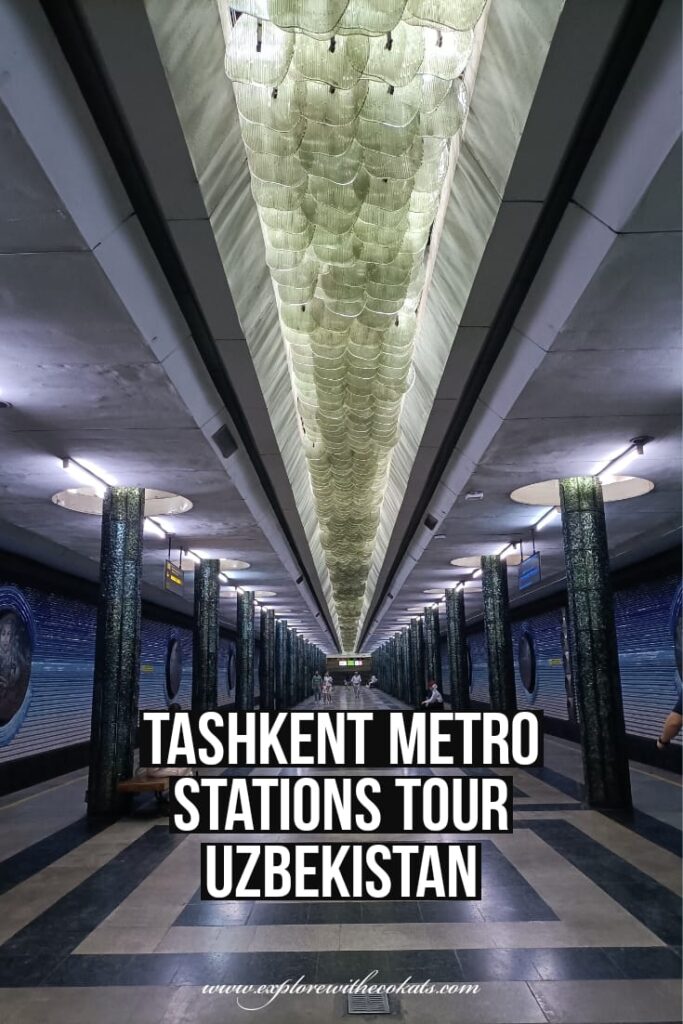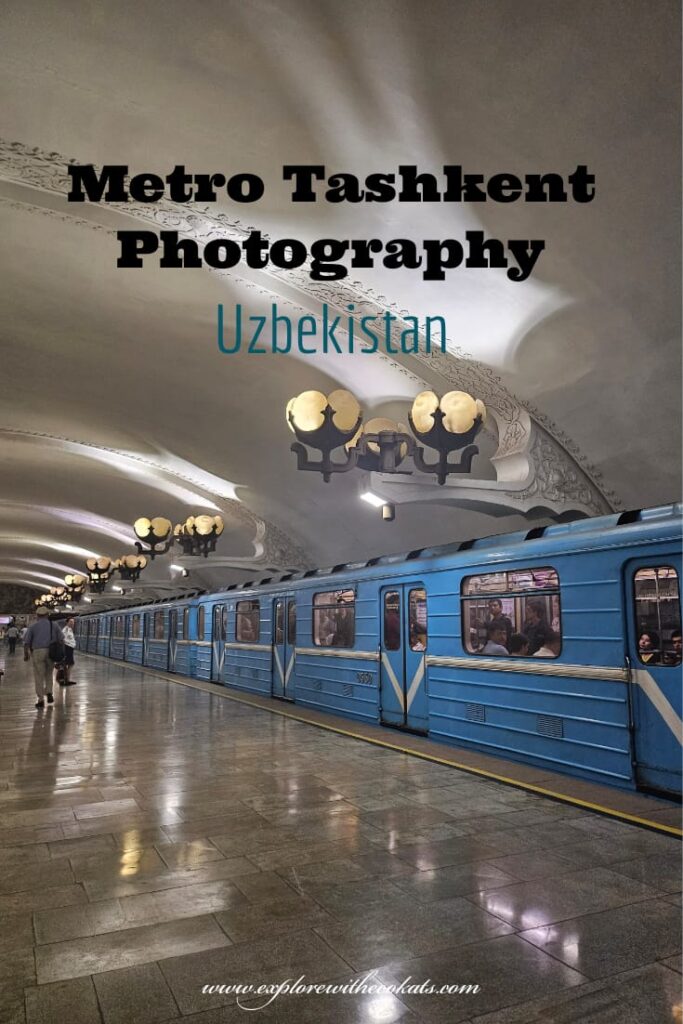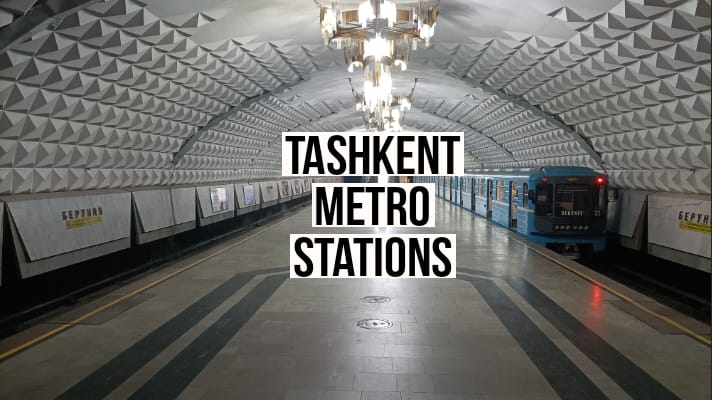Last Updated on May 17, 2024 by
This Tashkent Metro Stations Guide covers all the tips about riding the metro, most beautiful metro stations to visit in Tashkent, Tashkent metro map, Tashkent metro tickets cost, how to buy them, safety and photography.
Being a sustainable traveller I am always looking for ways to use public transport while travelling in a new city and country. Metro, trams, trains have a special place in my heart as they are light on the pocket and environment.
Although some may argue about the rush hour crowds, there is an advantage of being a tourist and crowds can be easily avoided by travelling in off hours.
Visiting the Tashkent Metro Stations was on my list of best things to do in Uzbekistan as it is one of the best Tashkent attractions.
Walking through the Tashkent subway stations is like strolling through the pages of the city’s history book. Each station unfolds a chapter of Uzbekistan’s past, narrating tales through portraits, plaques, and architectural marvels. These underground hubs vividly portray the enduring influence of the ancient Silk Road, the reigns of empires from bygone era, as well as pay a tribute to the significant figures that shaped the nation.
Nearly every metro station in Tashkent captivates the visitors with its distinctive architectural charm and artistic allure. From stations resembling opulent ballrooms adorned with grand chandeliers to others evoking the ambiance of a sci-fi film set, each one adds a fascinating layer to the city’s underground narrative.
Since I spent 2 days in Tashkent, I dedicated approximately 90 minutes to the metro ride to hop on and hop off across the Uzbekistan (Blue) line. After riding the Tashkent metro this is the perfect guide to the incredible Tashkent Metro Stations that you need!
The Tashkent metro runs through the city’s central area. It is easily recognised by the ‘M’ symbol at its entrance.
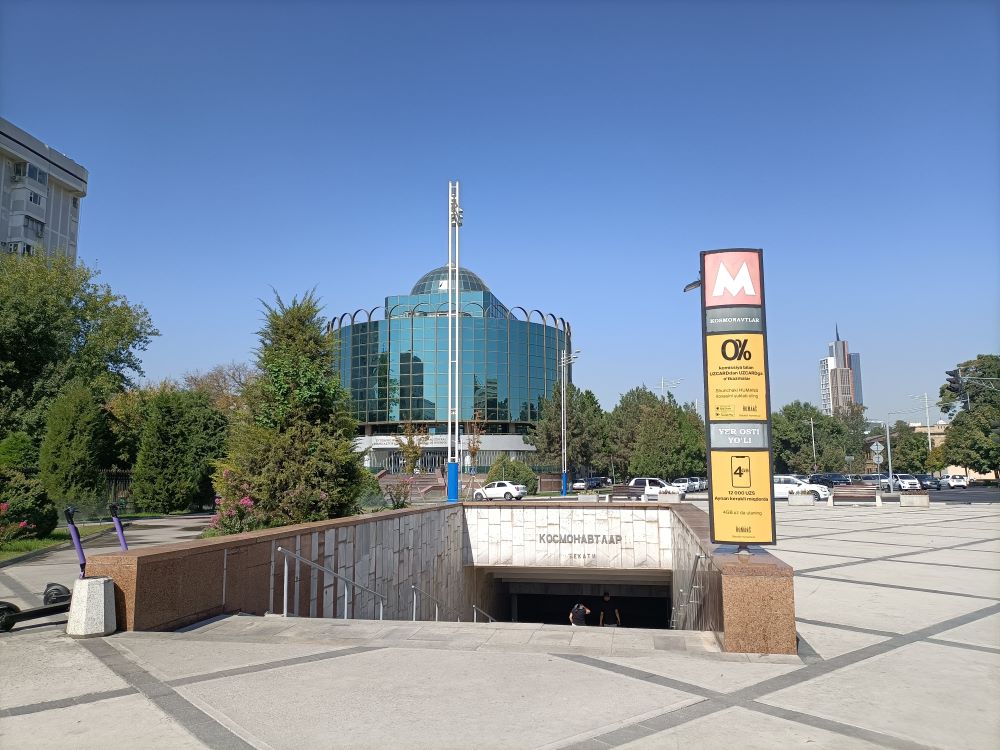
Table of Contents
ALL ABOUT METRO TASHKENT
Established in 1977, the Tashkent Metro stands as the oldest subway system in Central Asia and holds the seventh position among the 13 metro networks within the former Soviet Union. Comprising four lines that serve 50 stations, each Tashkent Metro station is uniquely themed.
The metro stations were initially conceived as a comprehensive city-wide nuclear shelter, which is why the Uzbek government classified the entire metro as a military facility, leading to a prolonged prohibition on photography that lasted for decades.
Thankfully, the metro Tashkent ban on photography was lifted in June 2018 and visitors can now capture the beauty of these stations.
HISTORY OF TASHKENT METRO STATIONS
The Tashkent metro was the first underground subway in Central Asia. During the Soviet era, a city could only have a public rail system if it had a population of 1 million.
In the 1960s Tashkent experienced a surge in population growth and the first metro line was completed and opened in 1977. A second line was added in 1991, the third one in 2001 and forth is undergoing.
The metro is currently over 70 kilometers long with 50 stations spread across the 4 metro lines. Most of the metro trains are still the same ones used during Soviet times.
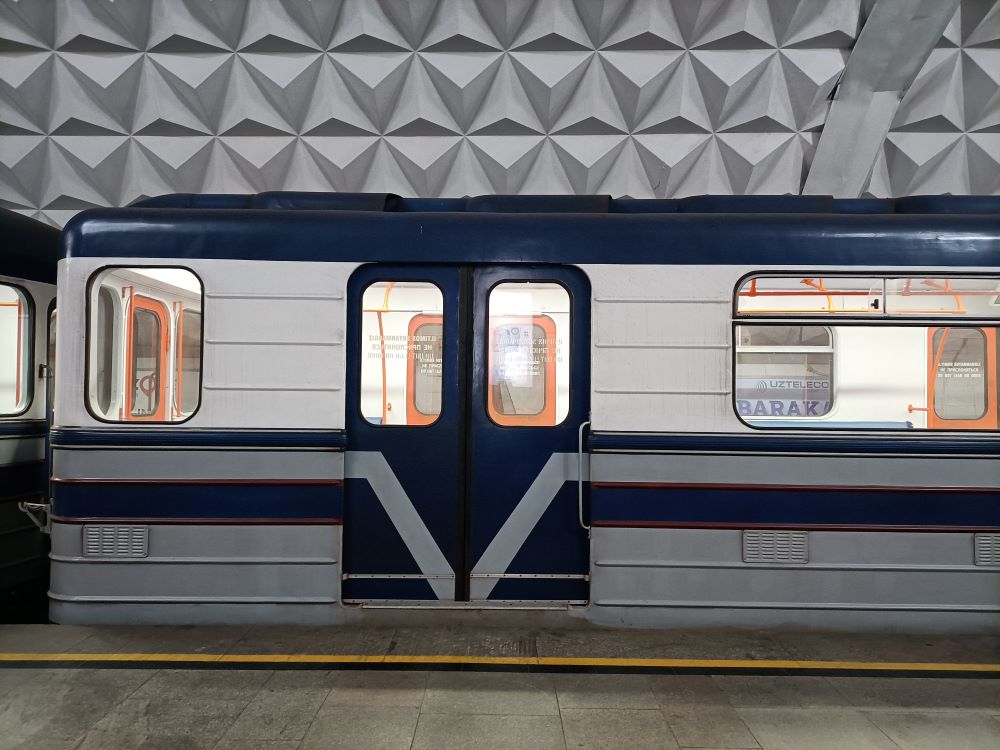
RIDING THE METRO TASHKENT – PRACTICAL INFORMATION
Tashkent Metro Map
First things first. In order to ride the metro, you need the map. This is the latest map that is uploaded on the official metro website. So have a look before going and keep it handy.
The metro in Tashkent now has 50 stations connected by 4 metro lines and each line has a different colour on the map.
Chilanzar Line (Red Line)
Uzbekistan Line (Blue Line)
Yunusabad Line (Green Line)
Sergeli line (Yellow Line)
The red line is called the Chilanzar Line and it was the very first line of the Tashkent Metro. It has 17 stations and connects the south of Tashkent to the center and the western area of the city.
Uzbekiston Line is the blue line on the map and was the metro’s second line to be opened. It has 11 stations and connects the northeastern and eastern areas of Tashkent to the city center. It has one of the most beautiful metro stations in the city.
Yunusabad Line is the green line which was inaugurated in 2001 and currently has 8 stations connecting the north of Tashkent to the city center.
The Sergeli line is yellow line and is a new metro line that opened in August 2020 and it has 14 stations which unites the city’s aboveground and underground lines into a single, integrated circuit. The work on this line is still ongoing. The extended system anticipates a daily ridership of up to 750,000 passengers.
Every station has a hall consisting of one central platform and one metro line runs on both sides of this platform in opposite directions.
The next stations along the line are indicated on the walls and panels next to the railroad.
There are 4 interchange stations – Pakhtakor/ Alisher Navoir, Amir Temur Avenue/ Yunus Rajabi, Mingurik/Oybek and Dustlik/ Technopark – where visitors can easily walk from one hall to another to take a different line.
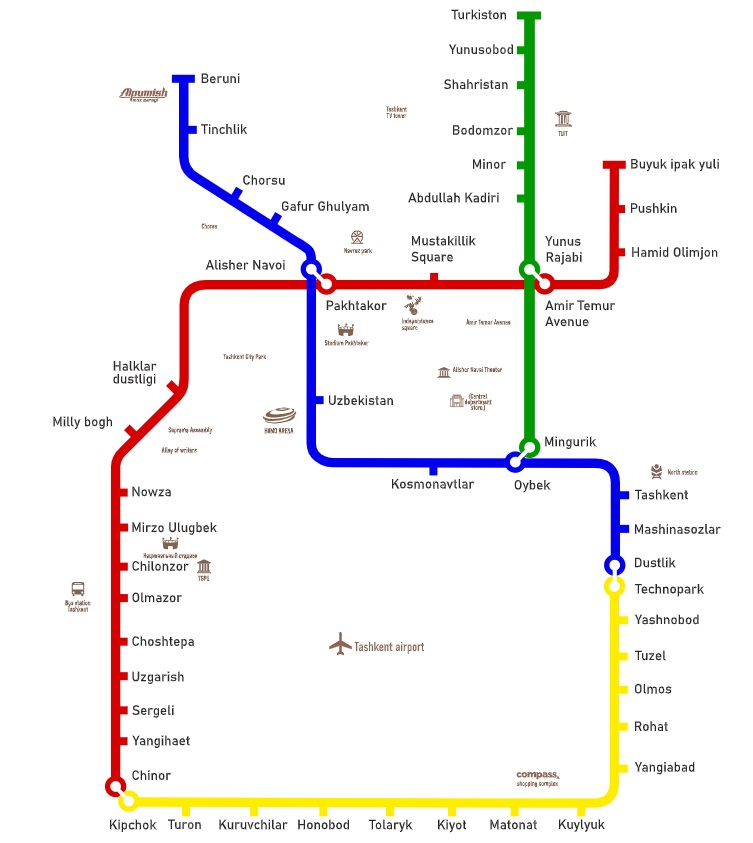
Opening hours of Tashkent Metro
The Tashkent Metro is open every day from 5 am until midnight. Peak hours are from 7.30 am to 9.30 am and from 5:30 pm to 7.30 pm.
The best time to visit the metro in Tashkent is during the early afternoon, between 10 am and 12 noon or between 1 pm to 4pm.
On weekdays, the average time between two trains is about 5 minutes until 9 pm. After 9 pm and on weekends and holidays, you can catch a train every 10 minutes.
Tashkent Metro Tickets
Visitors need to buy a one-time ticket. The flat rate is UZS 1400 ($0.11) no matter which station you get on and off. The tickets can be bought outside each metro station in a window named ‘kassa’. Most stations have a metro map.
I had the map downloaded and I pointed to the station I wanted to get to so it was easy for the issuer to understand.
Tourists can pay via cash. Locals use online rechargeable transport cards. The ticket has a unique QR code which is needed to enter the station as it opens the entry barrier.
The ticket is valid for 60 minutes so one can get off at a platform, explore the station, take photos and get on the next train.
Since you don’t exit the station, you can hop on and hop off the train to explore the Tashkent metro stations.
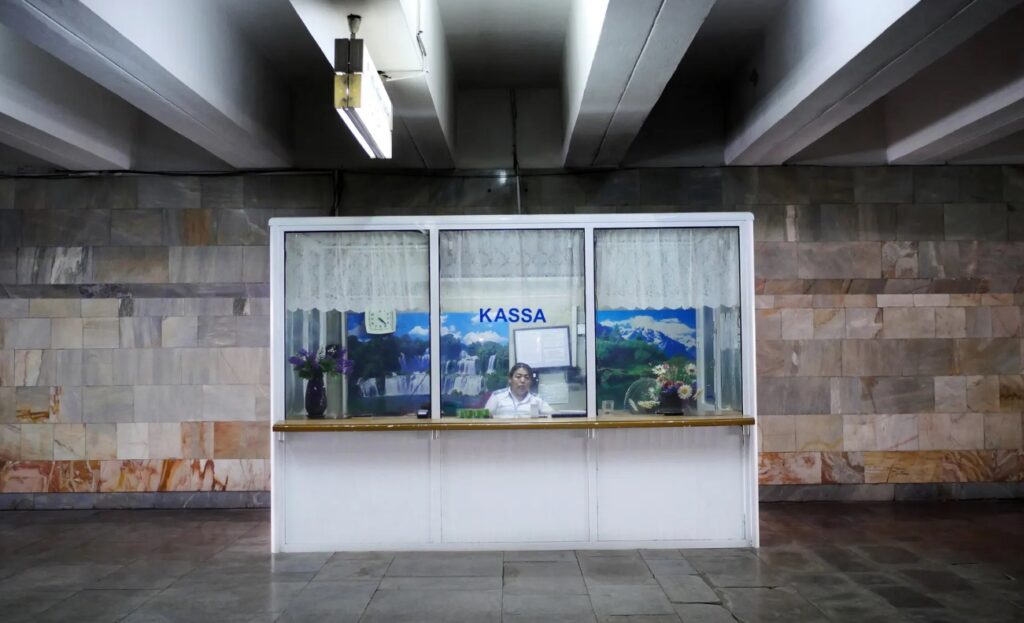
Security at Metro stations
Upon entering the metro station, you have to pass through the entry barrier using the QR code on your ticket. Just before that, your bags will be checked by officers in uniform. Laptop bags or big purses will be manually checked by opening. Once cleared you enter the station via escalator or staircase.
On the subway platform there will be security personnel. They will gather near the metro once the train is about to arrive and leave.
If the station is relatively empty, they may come up and chat with you, if you are taking photos. It happened at 2 stations with me and both the personnel could identify my nationality just by looking at me!
Is the Tashkent Metro safe?
From QR coded entry to the presence of security personnel and CCTV, riding the metro tashkent is extremely safe.
There are at least 2 security guards in green uniform at every station and more at interchange stations who are keeping a close eye on what’s happening on the platforms. If you ever feel unsafe, you can talk to them. Most of them can understand english.
Pickpocketing is unheard of in the metro but it’s always better to keep your money, valuables and passport safely.
BEST TASHKENT METRO STATIONS TO VISIT
While every metro station is beautiful in its own way, if you are a tourist, you will probably have only a little time. My suggestion is to explore the blue and red lines which are the oldest and have the most beautiful metro stations in Tashkent.
I made the best of my time by exploring and travelling in the metro. I rode the Uzbekistan (Blue) Line as I was staying in that area. I was able to walk and photograph 7 of them in 90 minutes. This also depends on the train frequency and how much time you are taking to explore the stations.
I started at Kosmonavtlar and went up to Beruni, getting off at each station.
Kosmonavtlar
Kosmonavtlar is a stunning space-programme-themed station of the Metro Tashkent. A memorial is constructed right outside the Kosmonavtlar metro station in the honor of Uzbekistan’s (previously Soviet Union) Cosmonauts such as Yuri Gagarin and Valentina Tereshkova, the first man and woman in space.
The area around the memorial is huge with a walking trail where locals come for an evening stroll.
The architecture inside of the metro station has a very ‘space’ kind of vibe. The vibrant ceramic walls transition from blue to black, mirroring the Earth’s atmosphere, while the dangling glass on the ceiling mimics the Milky Way. The entire colour scheme gives the feeling of gazing at the Milky Way on a clear dark night.
There are circular panels on the station walls that have murals featuring the same cosmonauts.
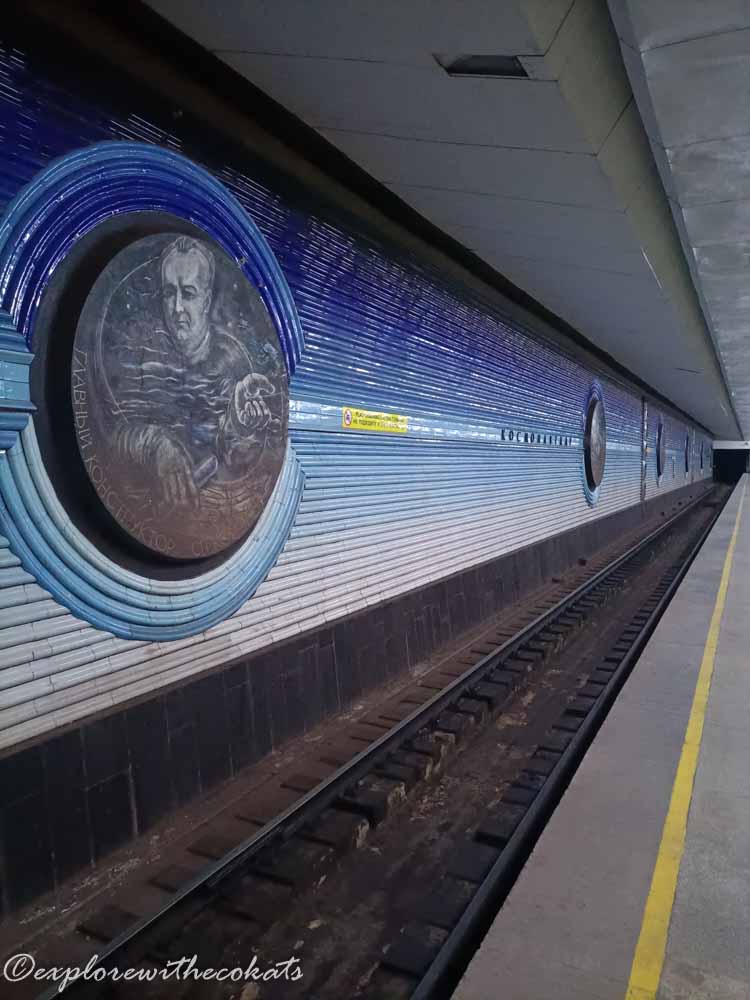
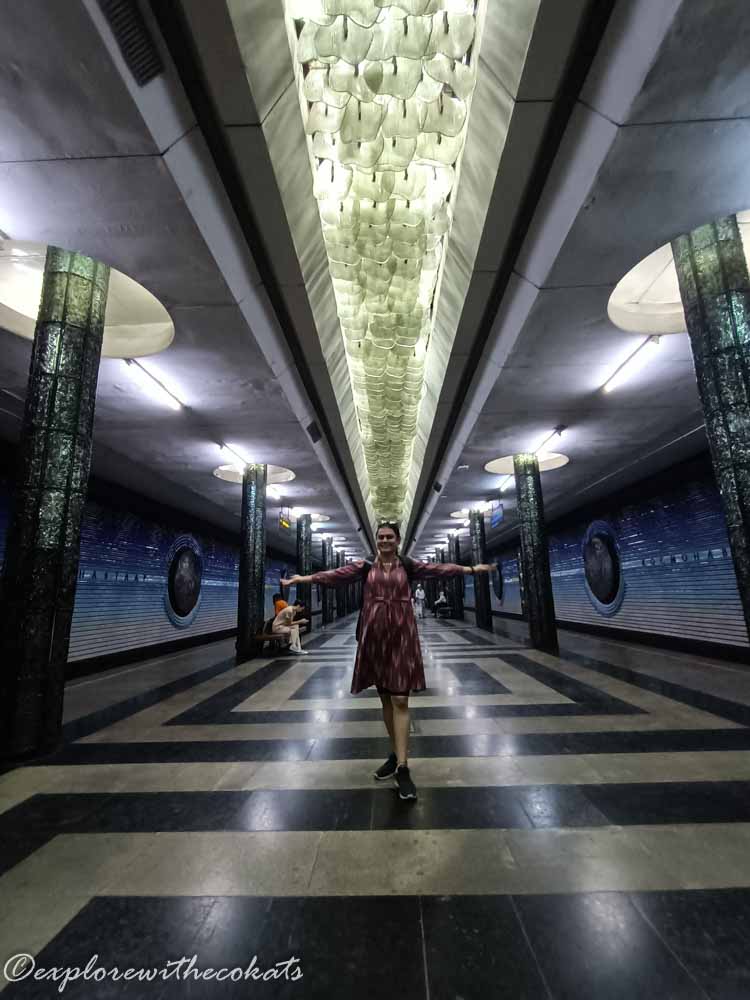
Uzbekistan
The light fixtures in the station look like giant bulbs of cotton plants and the shadow created by them on the ceiling makes the entire station look very beautiful. The bulbous lights actually pay tribute to the country’s cotton industry.
There are also blue glass mosaics on the walls that look like waves in the sea.
This station is generally empty and few locals get off which makes it very peaceful.
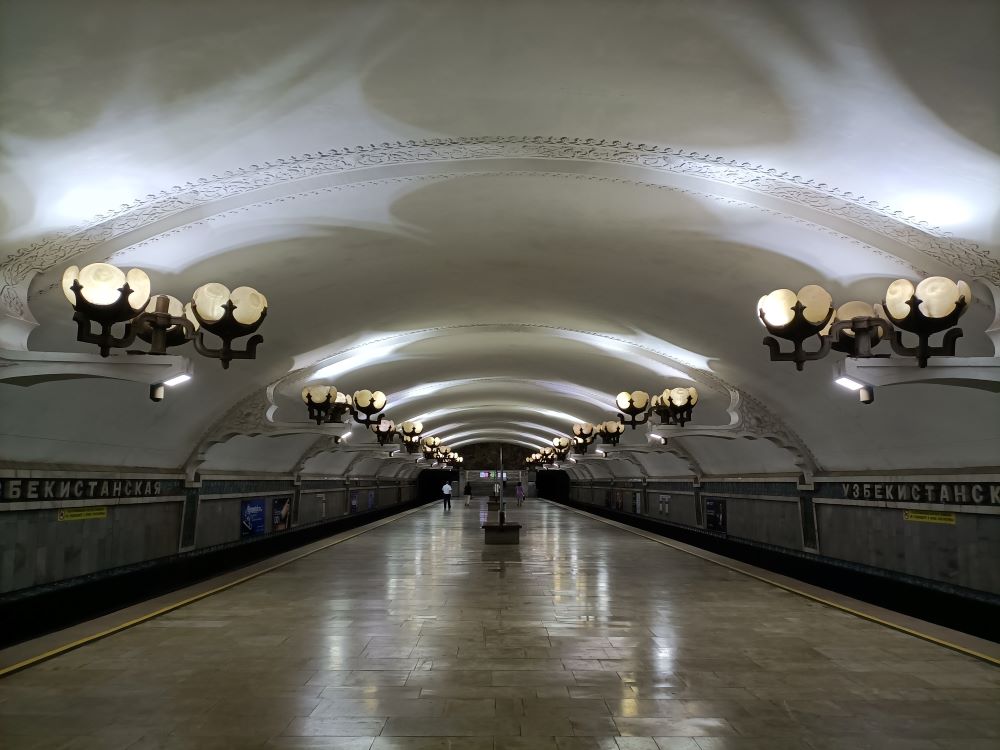
Pakhtakor
Paxtakor or Pakhtakor translates to ‘cotton picker’ and the walls of this station are covered in traditional-looking blue and yellow mosaics that depict blooming cotton plants.
Uzbekistan is one of the world’s leading producers in cotton and the industry plays an important role in the history of the Uzbek economy.
Alishner Navoiy
The Alisher Navoiy station, with its beautiful blue domes and their intricate golden patterns resemble the mosques and madrassas of Uzbekistan built during the Silk Road period, an Islamic architectural representation.
Alisher Navoiy is the interchange station between the Uzbekiston (Blue) Line and Chilanzar (Red) Line and is named after a 15th-century Uzbek poet and important writer during the Silk Road.
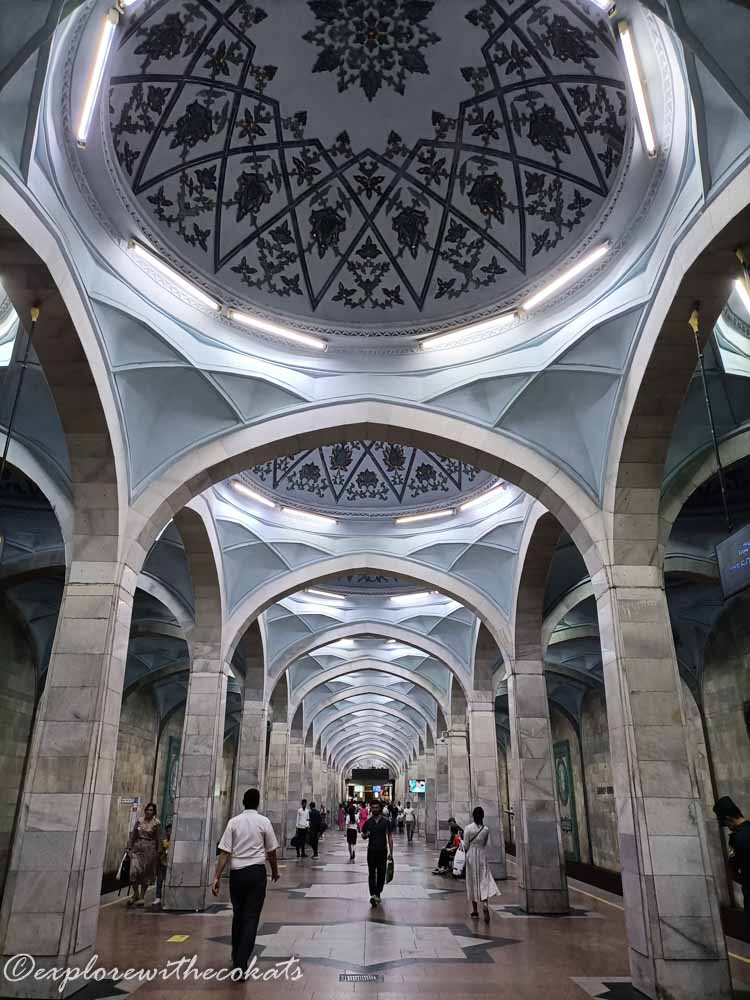
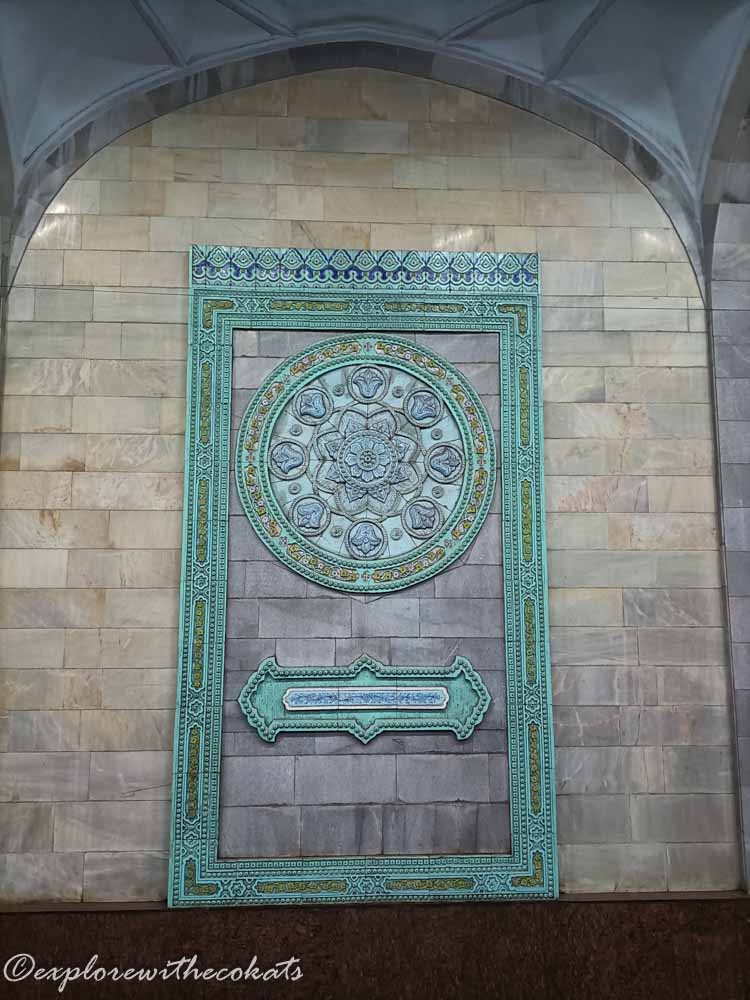
Gafur Gulom
Named in honour of G’afur G’ulom, a renowned Uzbek poet, writer, and translator, he is celebrated as one of the most impactful literary figures of the 20th century, particularly for his notable works like Shum Bola and Yodgor.
During the Soviet-German war against Nazi Germany, Gʻafur Gʻulom dedicated himself to chronicling the events of the war, and his poems gained immense popularity among the Uzbek people.
The station is embellished with columns crafted from turquoise granite, and the walls feature artistic ceramics portraying faces and visual representations inspired by G’ulom’s poetic creations.
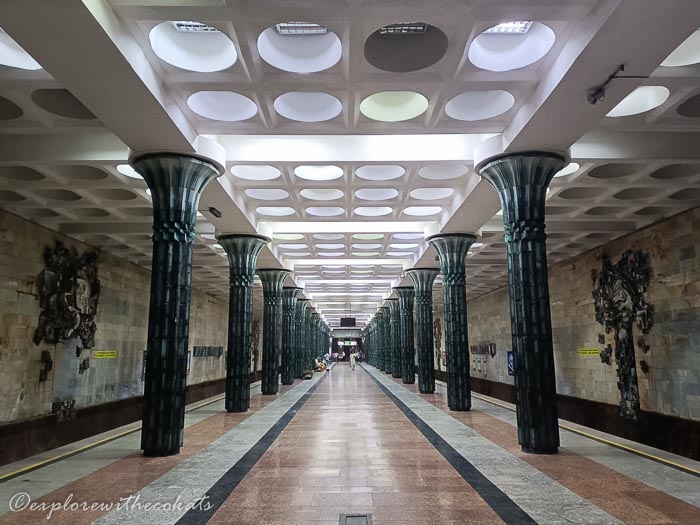
Chorsu
Named after the Chorsu Bazaar, the most happening shopping bazaar in Tashkent, Chorsu means four streams. The design on walls and ceiling in Chorsu have four coloured streams.
This station is not very well decorated but one of the most crowded as locals and tourists come here for shopping.
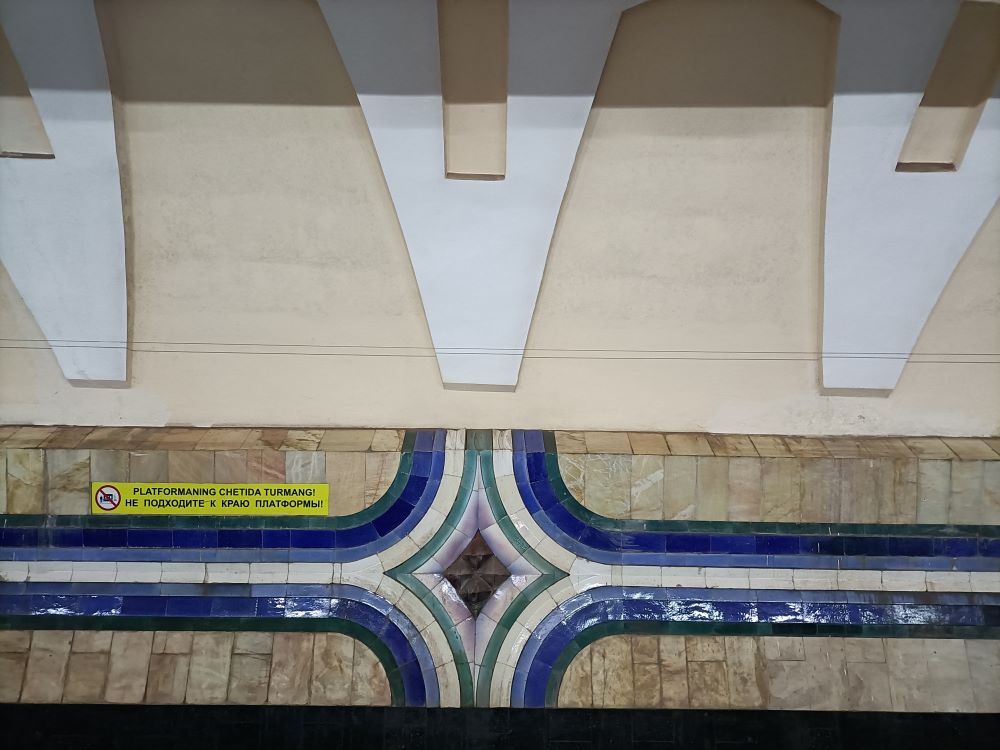
Tinchlik
The station is dedicated to Tinchlink, a small town where marble is mined in Uzbekistan.
Mukhamadjon R. and A. Kayumov were the designers behind Tinchlik Station, which boasts elaborate embellishments such as stained glass walls, marble columns adorned with illuminating lamps, and crystal chandeliers suspended from the ceiling.
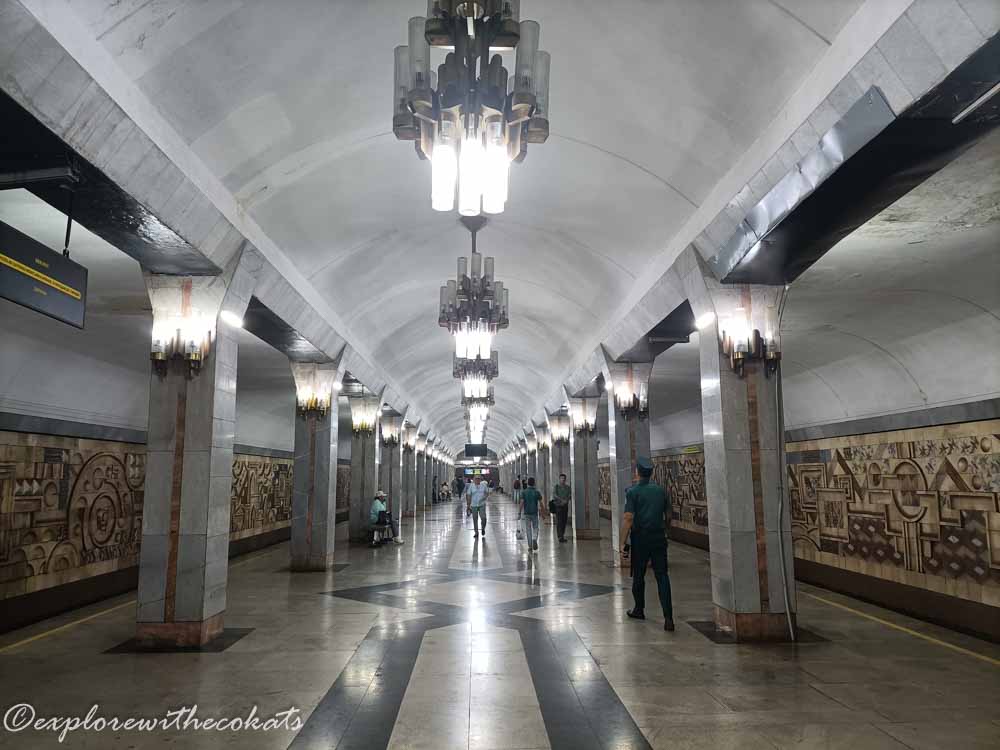
Beruniy
Beruniy station is named after the poet Al-Biruni, a polymath from Karakalpakstan in Uzbekistan.
What makes this station special is the white arched ceiling with geometrical patterns and golden crystal chandeliers hanging from the ceiling.
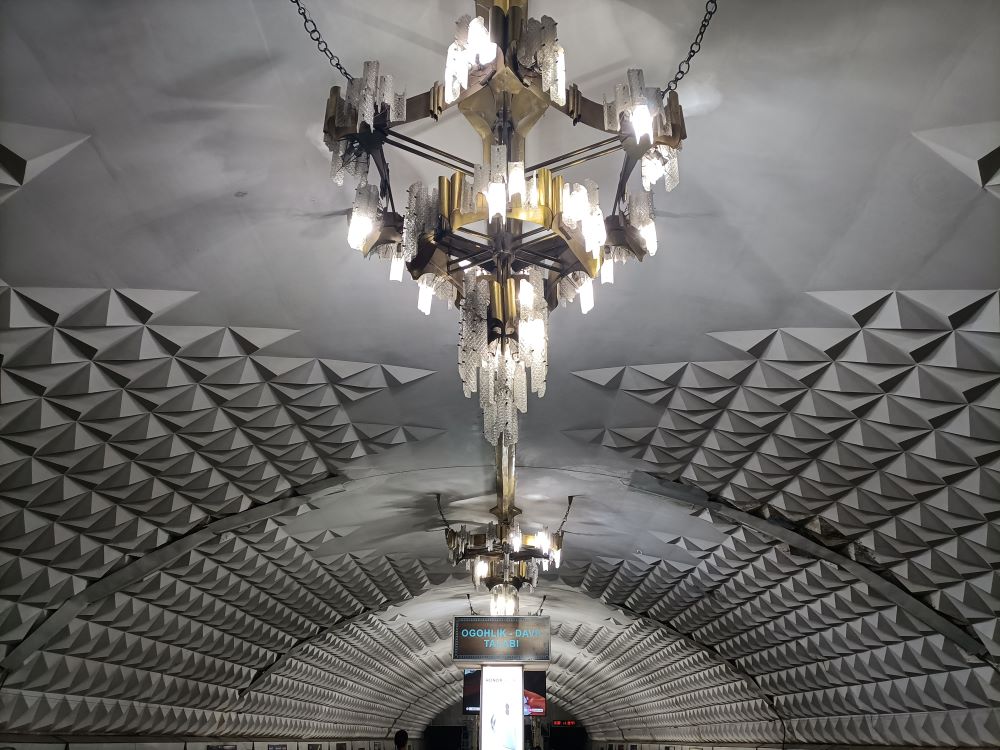
SUSTAINABLE TIPS FOR VISITING TASHKENT METRO STATIONS
- Using the metro itself is the first step towards sustainability so hurray and pat yourself on the back!
- Do not trash the metro station with waste. Use designated areas and bins for disposing of waste.
- Be mindful of all the signs and follow them respectfully, especially dedicated seats for handicapped or pregnant women in the train.
Which of these stations stand out for you? Have you ever visited such beautiful metro stations in the world? Let me know in the comments below!
Looking for more Uzbekistan Inspiration? Read Here
- Things to do in Samarkand
- Uzbekistan Travel Guide
- Things to do in Bukhara
- Tashkent Attractions
- Souvenirs to buy from Uzbekistan
- Things to do in Khiva
- Vegetarian food in Uzbekistan
- Travelling by train in Uzbekistan
Disclaimer: This post contains affiliate links. It means it adds no extra cost to you if you book through the link but I get a referral bonus which helps me earn a little to keep this website up and running. Read this Privacy Policy to know more.
PIN THIS POST!
